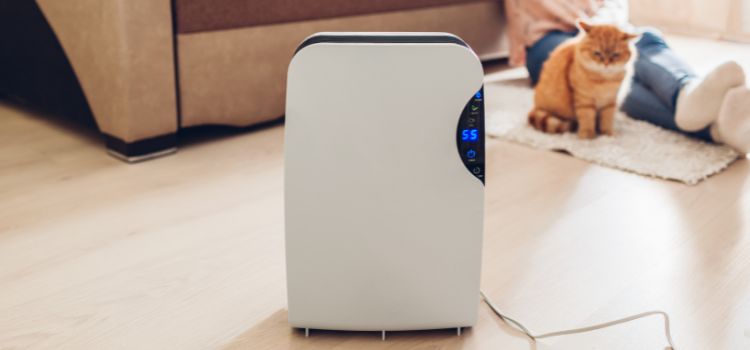As an Amazon Associate I earn from qualifying purchases.
Appliances that maintain the best possible interior air quality and stop problems like the development of mold and mildew are dehumidifiers. But having issues with your dehumidifier, such hot air spewing out of it, may be annoying and worrisome. This article will examine the causes of the problem and provide workarounds to fix it successfully.

Introduction to Dehumidifiers
Dehumidifiers function by removing excess moisture from the air, effectively lowering humidity levels. They are commonly used to foster a cozier and healthier atmosphere in homes, basements, and other enclosed spaces.
How Dehumidifiers Work
Humid air is drawn in by a fan and circulated over chilled coils in dehumidifiers. Dryer air is left behind after the air cools and condenses on the coils, dripping into a drainage system or collecting bucket. The dry air is then recirculated into the room.
Common Issues with Dehumidifiers
Although dehumidifiers are typically dependable appliances, they may encounter a number of issues over time, such as broken parts, decreased performance, and strange behavior.
Overview of Hot Air Issue
A frequent problem that consumers could run into is that their dehumidifier is spewing hot air instead of dry, cold air. This behavior may indicate underlying issues that require immediate attention to ensure the device operates appropriately.
Reasons Your Dehumidifier Might Blow Hot Air
When a dehumidifier blows hot air instead of efficiently removing moisture from the air, there are a number of reasons why this could happen.
Improper Settings
The dehumidifier control panel may have incorrect settings or modifications that result in inefficient operation or heated air output. Users should verify that the device is appropriately set up for the intended humidity level and operating mode by reviewing the settings again.
Mechanical Faults
A broken compressor, fan motor, or refrigeration system are examples of mechanical problems that might lead to a dehumidifier blowing hot air. For these parts to operate properly again, a trained technician may need to replace or repair them.
Environmental Factors
External elements like excessive heat or inadequate ventilation may also have an impact on a dehumidifier’s effectiveness. Placing the device in an area that is too hot or has inadequate ventilation may hinder its ability to absorb moisture efficiently, leading to the release of hot air instead.
Effects of Hot Air Blowing from Dehumidifiers
There are a number of unfavorable consequences that hot air from a dehumidifier may have on the comfort and quality of indoor air. Hot air output not only doesn’t lower humidity levels, but it may also raise room temperatures and make people uncomfortable.
Troubleshooting Hot Air Issue
There are a few things you can do to diagnose and fix your dehumidifier if it is spewing hot air.
Checking Settings
Ensure that the dehumidifier control panel settings are adjusted appropriately by reviewing the settings. To achieve the required humidity level and operating mode—such as continuous or automated operation—adjust the parameters as necessary.
Inspecting Filters and Coils
Check the air filters and the coils within the refrigerator for any evidence of accumulated dust, debris, or filth. To clear any buildup that could be preventing airflow and causing the unit to overheat, clean or replace any filthy filters and gently brush or vacuum the coils.
Testing Temperature and Humidity Levels
To test the room’s temperature and humidity, use a separate thermometer and hygrometer. To get the best comfort and moisture management, compare these readings to the dehumidifier’s settings and make the necessary adjustments.
Preventive Maintenance Tips
In order to avoid problems such as hot air blasting from your dehumidifier, it’s imperative that you carry out routine maintenance and heed these advisory tips:
Regular Cleaning
Frequent cleaning of the air filters, coils, water collecting bucket, and drainage system is necessary to avoid the accumulation of dirt, dust, and mold, which may hinder airflow and negatively impact performance.
Proper Placement
Place the dehumidifier in a well-ventilated location away from heat sources, direct sunlight, and any obstructions to airflow. For best performance, make sure there is enough space around the device.
Scheduled Servicing
Plan to have your dehumidifier professionally serviced and inspected at least once a year to identify and address any potential problems early on. Frequent maintenance can guarantee effective performance and increase the device’s lifetime.
Seeking Professional Help
When troubleshooting techniques don’t work to fix your dehumidifier’s hot air problem, it may be time to call an expert.
When DIY Fixes Fail
For further diagnosis and repair if do-it-yourself maintenance and troubleshooting are ineffective, get in touch with a licensed technician or HVAC professional. Trying to fix complicated mechanical problems on your own without the right knowledge and experience might do more harm or put your safety in danger.
Choosing a Reliable Technician
Choose an established, skilled technician with a history of providing dependable service and satisfied customers to repair your dehumidifier. Check their qualifications, insurance, and licensing before giving them the repair job.
Conclusion
When your dehumidifier blows hot air, there might be a number of underlying problems, such as incorrect settings, mechanical problems, or environmental conditions. Through comprehending the causes of this problem and putting troubleshooting techniques and preventative maintenance advice into practice, you can get your dehumidifier working again and guarantee the best possible interior comfort and air quality.
FAQs
Even during winter, you can use dehumidifiers year-round to maintain optimal interior humidity levels.
Low temperatures or technical problems, such a malfunctioning defrost sensor or low refrigerant levels, may cause freezing.
To prevent dirt and debris buildup, we recommend cleaning your dehumidifier’s air filters and coils every few weeks.
Many dehumidifiers operate continuously, allowing you to leave them running for optimal moisture management.
As an Amazon Associate I earn from qualifying purchases.








